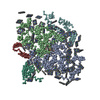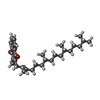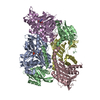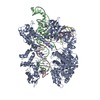[English] 日本語
 Yorodumi
Yorodumi- PDB-2pps: PHOTOSYNTHETIC REACTION CENTER AND CORE ANTENNA SYSTEM (TRIMERIC)... -
+ Open data
Open data
- Basic information
Basic information
| Entry | Database: PDB / ID: 2pps | ||||||||||||
|---|---|---|---|---|---|---|---|---|---|---|---|---|---|
| Title | PHOTOSYNTHETIC REACTION CENTER AND CORE ANTENNA SYSTEM (TRIMERIC), ALPHA CARBON ONLY | ||||||||||||
 Components Components | (PHOTOSYSTEM I ) x 6 ) x 6 | ||||||||||||
 Keywords Keywords |  PHOTOSYNTHESIS / PHOTOSYNTHESIS /  PHOTOSYNTHETIC REACTION CENTER / OXYGENIC PHOTOSYNTHESIS / CORE-ANTENNA LIGHT-HARVESTING SYSTEM / THERMOPHILIC CYANOBACTERIUM / HELIX-BUNDLE MEMBRANE PROTEIN PHOTOSYNTHETIC REACTION CENTER / OXYGENIC PHOTOSYNTHESIS / CORE-ANTENNA LIGHT-HARVESTING SYSTEM / THERMOPHILIC CYANOBACTERIUM / HELIX-BUNDLE MEMBRANE PROTEIN | ||||||||||||
| Function / homology |  CHLOROPHYLL A / CHLOROPHYLL A /  PHYLLOQUINONE / PHYLLOQUINONE /  IRON/SULFUR CLUSTER IRON/SULFUR CLUSTER Function and homology information Function and homology information | ||||||||||||
| Biological species |   Synechococcus elongatus (bacteria) Synechococcus elongatus (bacteria) | ||||||||||||
| Method |  X-RAY DIFFRACTION / X-RAY DIFFRACTION /  SYNCHROTRON / SYNCHROTRON /  MIR / Resolution: 4 Å MIR / Resolution: 4 Å | ||||||||||||
 Authors Authors | Krauss, N. / Schubert, W.-D. / Klukas, O. / Fromme, P. / Witt, H.T. / Saenger, W. | ||||||||||||
 Citation Citation |  Journal: Nat.Struct.Biol. / Year: 1996 Journal: Nat.Struct.Biol. / Year: 1996Title: Photosystem I at 4 A resolution represents the first structural model of a joint photosynthetic reaction centre and core antenna system. Authors: Krauss, N. / Schubert, W.D. / Klukas, O. / Fromme, P. / Witt, H.T. / Saenger, W. #1:  Journal: J.Mol.Biol. / Year: 1997 Journal: J.Mol.Biol. / Year: 1997Title: Photosystem I of Synechococcus Elongatus at 4 A Resolution: Comprehensive Structure Analysis Authors: Schubert, W.D. / Klukas, O. / Krauss, N. / Saenger, W. / Fromme, P. / Witt, H.T. #2:  Journal: Photosynthesis : From Light to Biosphere : Proceedings of the Xth International Photosynthesis Congress, Montpellier, France, 20-25 August 1995 Journal: Photosynthesis : From Light to Biosphere : Proceedings of the Xth International Photosynthesis Congress, Montpellier, France, 20-25 August 1995Year: 1995 Title: Present State of the Crystal Structure Analysis of Photosystem I at 4.5 A Resolution Authors: Schubert, W.D. / Klukas, O. / Krauss, N. / Saenger, W. / Fromme, P. / Witt, H.T. #3:  Journal: Nature / Year: 1993 Journal: Nature / Year: 1993Title: Three-Dimensional Structure of System I of Photosynthesis at 6A Resolution, Authors: Krauss, N. / Hinrichs, W. / Witt, I. / Fromme, P. / Pritzkow, W. / Dauter, Z. / Betzel, C. / Wilson, K.S. / Witt, H.T. / Saenger, W. #4:  Journal: Ber.Bunsenges.Phys.Chem. / Year: 1988 Journal: Ber.Bunsenges.Phys.Chem. / Year: 1988Title: X-Ray Characterization of Single Crystals of the Reaction Center I of Water Splitting Photosynthesis Authors: Witt, I. / Witt, H.T. / Di Fiore, D. / Rogner, M. / Hinrichs, W. / Saenger, W. / Granzin, J. / Betzel, C. / Dauter, Z. | ||||||||||||
| History |
|
- Structure visualization
Structure visualization
| Structure viewer | Molecule:  Molmil Molmil Jmol/JSmol Jmol/JSmol |
|---|
- Downloads & links
Downloads & links
- Download
Download
| PDBx/mmCIF format |  2pps.cif.gz 2pps.cif.gz | 120.6 KB | Display |  PDBx/mmCIF format PDBx/mmCIF format |
|---|---|---|---|---|
| PDB format |  pdb2pps.ent.gz pdb2pps.ent.gz | 83.2 KB | Display |  PDB format PDB format |
| PDBx/mmJSON format |  2pps.json.gz 2pps.json.gz | Tree view |  PDBx/mmJSON format PDBx/mmJSON format | |
| Others |  Other downloads Other downloads |
-Validation report
| Arichive directory |  https://data.pdbj.org/pub/pdb/validation_reports/pp/2pps https://data.pdbj.org/pub/pdb/validation_reports/pp/2pps ftp://data.pdbj.org/pub/pdb/validation_reports/pp/2pps ftp://data.pdbj.org/pub/pdb/validation_reports/pp/2pps | HTTPS FTP |
|---|
-Related structure data
| Similar structure data |
|---|
- Links
Links
- Assembly
Assembly
| Deposited unit | 
| ||||||||
|---|---|---|---|---|---|---|---|---|---|
| 1 |
| ||||||||
| Unit cell |
|
- Components
Components
-Protein , 6 types, 6 molecules ABLKFC
| #1: Protein |  / PSI / SYSTEM I OF OXYGENIC PHOTOSYNTHESIS / Coordinate model: Cα atoms only / PSI / SYSTEM I OF OXYGENIC PHOTOSYNTHESIS / Coordinate model: Cα atoms onlyMass: 40698.164 Da / Num. of mol.: 1 Fragment: THE PSI-PROTOMER IS A COMPLEX OF PSAA, PSAB, PSAC, PSAD, PSAE, PSAF, PSAI, PSAJ, PSAK, PSAL, PSAM Source method: isolated from a natural source / Source: (natural)   Synechococcus elongatus (bacteria) / Cellular location: THYLAKOID MEMBRANE Synechococcus elongatus (bacteria) / Cellular location: THYLAKOID MEMBRANE Thylakoid Thylakoid |
|---|---|
| #2: Protein |  / PSI / SYSTEM I OF OXYGENIC PHOTOSYNTHESIS / Coordinate model: Cα atoms only / PSI / SYSTEM I OF OXYGENIC PHOTOSYNTHESIS / Coordinate model: Cα atoms onlyMass: 42825.812 Da / Num. of mol.: 1 Fragment: THE PSI-PROTOMER IS A COMPLEX OF PSAA, PSAB, PSAC, PSAD, PSAE, PSAF, PSAI, PSAJ, PSAK, PSAL, PSAM Source method: isolated from a natural source / Source: (natural)   Synechococcus elongatus (bacteria) / Cellular location: THYLAKOID MEMBRANE Synechococcus elongatus (bacteria) / Cellular location: THYLAKOID MEMBRANE Thylakoid Thylakoid |
| #3: Protein |  / PSI / SYSTEM I OF OXYGENIC PHOTOSYNTHESIS / Coordinate model: Cα atoms only / PSI / SYSTEM I OF OXYGENIC PHOTOSYNTHESIS / Coordinate model: Cα atoms onlyMass: 9464.658 Da / Num. of mol.: 1 Fragment: THE PSI-PROTOMER IS A COMPLEX OF PSAA, PSAB, PSAC, PSAD, PSAE, PSAF, PSAI, PSAJ, PSAK, PSAL, PSAM Source method: isolated from a natural source / Source: (natural)   Synechococcus elongatus (bacteria) / Cellular location: THYLAKOID MEMBRANE Synechococcus elongatus (bacteria) / Cellular location: THYLAKOID MEMBRANE Thylakoid Thylakoid |
| #4: Protein |  / PSI / SYSTEM I OF OXYGENIC PHOTOSYNTHESIS / Coordinate model: Cα atoms only / PSI / SYSTEM I OF OXYGENIC PHOTOSYNTHESIS / Coordinate model: Cα atoms onlyMass: 5464.728 Da / Num. of mol.: 1 Fragment: THE PSI-PROTOMER IS A COMPLEX OF PSAA, PSAB, PSAC, PSAD, PSAE, PSAF, PSAI, PSAJ, PSAK, PSAL, PSAM Source method: isolated from a natural source / Source: (natural)   Synechococcus elongatus (bacteria) / Cellular location: THYLAKOID MEMBRANE Synechococcus elongatus (bacteria) / Cellular location: THYLAKOID MEMBRANE Thylakoid Thylakoid |
| #5: Protein |  / PSI / SYSTEM I OF OXYGENIC PHOTOSYNTHESIS / Coordinate model: Cα atoms only / PSI / SYSTEM I OF OXYGENIC PHOTOSYNTHESIS / Coordinate model: Cα atoms onlyMass: 11081.651 Da / Num. of mol.: 1 Fragment: THE PSI-PROTOMER IS A COMPLEX OF PSAA, PSAB, PSAC, PSAD, PSAE, PSAF, PSAI, PSAJ, PSAK, PSAL, PSAM Source method: isolated from a natural source / Source: (natural)   Synechococcus elongatus (bacteria) / Cellular location: THYLAKOID MEMBRANE Synechococcus elongatus (bacteria) / Cellular location: THYLAKOID MEMBRANE Thylakoid Thylakoid |
| #6: Protein |  / PSI / SYSTEM I OF OXYGENIC PHOTOSYNTHESIS / Coordinate model: Cα atoms only / PSI / SYSTEM I OF OXYGENIC PHOTOSYNTHESIS / Coordinate model: Cα atoms onlyMass: 6826.406 Da / Num. of mol.: 1 Fragment: THE PSI-PROTOMER IS A COMPLEX OF PSAA, PSAB, PSAC, PSAD, PSAE, PSAF, PSAI, PSAJ, PSAK, PSAL, PSAM Source method: isolated from a natural source / Source: (natural)   Synechococcus elongatus (bacteria) / Cellular location: THYLAKOID MEMBRANE Synechococcus elongatus (bacteria) / Cellular location: THYLAKOID MEMBRANE Thylakoid Thylakoid |
-Non-polymers , 3 types, 93 molecules 




| #7: Chemical | ChemComp-CLA /  Chlorophyll a Chlorophyll a#8: Chemical | ChemComp-PQN / |  Phytomenadione Phytomenadione#9: Chemical |  Iron–sulfur cluster Iron–sulfur cluster |
|---|
-Details
| Compound details | CHAIN A COMPRISES ONE OF THE TWO LARGE, CENTRAL, MEMBRANE INTEGRAL SUBUNITS OF THE REACTION CENTER ...CHAIN A COMPRISES ONE OF THE TWO LARGE, CENTRAL, MEMBRANE INTEGRAL SUBUNITS OF THE REACTION CENTER OF PSI - EITHER PSAA OR PSAB. CHAIN B COMPRISES THE SECOND OF THE TWO LARGE, CENTRAL, MEMBRANE INTEGRAL SUBUNITS OF THE REACTION CENTER OF PSI - EITHER PSAB OR PSAA. CHAIN C COMPRISES THE MODEL OF THE STROMAL EXTRINSIC SUBUNIT OF PSI - PSAC. CHAIN F COMPRISES THOSE SECTIONS OF THE PRESENT MODEL LOCATED DISTAL TO THE TRIMERIZAT |
|---|---|
| Nonpolymer details | THE ATOM NAMING OF THE CHLOROPHYLL MOLECULES IS ARBITRARY IN THE SENSE THAT THE AUTHORS DO NOT WISH ...THE ATOM NAMING OF THE CHLOROPHYL |
-Experimental details
-Experiment
| Experiment | Method:  X-RAY DIFFRACTION / Number of used crystals: 1 X-RAY DIFFRACTION / Number of used crystals: 1 |
|---|
- Sample preparation
Sample preparation
| Crystal | Density % sol: 80 % | ||||||||||||||||||||||||
|---|---|---|---|---|---|---|---|---|---|---|---|---|---|---|---|---|---|---|---|---|---|---|---|---|---|
Crystal grow | pH: 6.4 Details: PROTEIN CONCENTRATION:80 MG/ML METHOD: MICRODIALYSIS BUFFER: 0.02% BETA-DODECYLMALTOSIDE, 5 MM MES, PH 6.4 | ||||||||||||||||||||||||
| Crystal grow | *PLUS Temperature: 4 ℃ / Method: unknown | ||||||||||||||||||||||||
| Components of the solutions | *PLUS
|
-Data collection
| Diffraction | Mean temperature: 279 K |
|---|---|
| Diffraction source | Source:  SYNCHROTRON / Site: SYNCHROTRON / Site:  EMBL/DESY, HAMBURG EMBL/DESY, HAMBURG  / Beamline: X11 / Wavelength: 0.92 / Beamline: X11 / Wavelength: 0.92 |
| Detector | Type: MARRESEARCH / Detector: IMAGE PLATE / Date: Jul 1, 1993 / Details: FLAT SEGMENTED MIRROR |
| Radiation | Monochromator: BENT CYLINDRICAL GE(111) / Monochromatic (M) / Laue (L): M / Scattering type: x-ray |
| Radiation wavelength | Wavelength : 0.92 Å / Relative weight: 1 : 0.92 Å / Relative weight: 1 |
| Reflection | Resolution: 3.85→34.9 Å / Num. obs: 69153 / % possible obs: 94.4 % / Observed criterion σ(I): 3 / Redundancy: 2.8 % / Rmerge(I) obs: 0.085 / Rsym value: 0.102 / Net I/σ(I): 6.4 |
| Reflection shell | Resolution: 3.85→3.95 Å / Redundancy: 2 % / Mean I/σ(I) obs: 3.6 / Rsym value: 0.173 / % possible all: 81.3 |
| Reflection shell | *PLUS % possible obs: 81.3 % / Rmerge(I) obs: 0.173 |
- Processing
Processing
| Software |
| |||||||||||||||
|---|---|---|---|---|---|---|---|---|---|---|---|---|---|---|---|---|
| Refinement | Method to determine structure : :  MIR / Highest resolution: 4 Å MIR / Highest resolution: 4 ÅDetails: MODEL STRUCTURE IS BASED ON 4.0 ANGSTROM MIR MAP. THERE WAS NO REFINEMENT DUE TO LIMITED RESOLUTION. | |||||||||||||||
| Refinement step | Cycle: LAST / Highest resolution: 4 Å
|
 Movie
Movie Controller
Controller










 PDBj
PDBj







